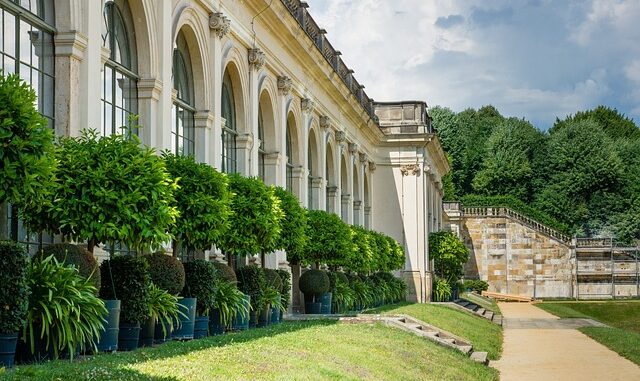
Summary
This article explores the synergy between orangeries and gardens, guiding you through design principles and plant choices to create a harmonious outdoor space. Discover how to enhance your orangery’s aesthetic appeal and create a seamless transition between indoor and outdoor living.
Bring light and luxury to your life with a uniquely designed orangery by the craftsmen at Elegancia.homes.
** Main Story**
An orangery provides a unique opportunity to connect with nature while enjoying the comforts of indoor living. Designing a garden that complements your orangery involves careful consideration of various factors, including style, color, planting choices, and practicalities. By following these steps, you can create a seamless transition between your orangery and garden, maximizing the enjoyment of both spaces.
Step 1: Define Your Style
Start by identifying the overall style and aesthetic you envision for your garden. Do you prefer a formal, symmetrical look, a relaxed cottage garden, or a modern, minimalist design? Understanding your preferred style helps guide plant choices, hardscaping materials, and overall layout. Research different garden styles and gather inspiration to create a mood board that reflects your vision.
Step 2: Analyze Your Site
Before selecting plants, carefully assess your garden’s existing conditions. Note the soil type, sunlight exposure, and prevailing wind patterns. These factors influence plant selection and ensure that your chosen species thrive in their designated locations. Consider conducting a soil test to determine its pH level and nutrient content, enabling you to amend the soil if necessary. Additionally, evaluate the microclimates within your garden, as areas closer to the orangery might experience warmer temperatures.
Step 3: Harmonize Colors
Create a cohesive color scheme that complements your orangery’s exterior and interior. Consider the colors of the brickwork, paint finishes, and interior décor. Choose plants with flower and foliage colors that either harmonize with or create a pleasing contrast against these existing elements. Use a color wheel to understand color relationships and select combinations that create the desired mood. For example, analogous colors (adjacent on the color wheel) create a sense of harmony, while complementary colors (opposite on the color wheel) offer a vibrant contrast.
Step 4: Choose Plants Wisely
Select plants that not only suit your chosen style and site conditions but also offer year-round interest. Incorporate a mix of evergreen shrubs, flowering perennials, and seasonal annuals to ensure continuous color and texture throughout the year. Consider the mature size and shape of plants to avoid overcrowding and create a balanced composition. Architectural plants with bold foliage or striking bark can act as focal points, while smaller plants provide filler and ground cover. Remember to choose plants that can cope with temperature fluctuations, levels of sunlight, and humidity conditions near your orangery.
Step 5: Enhance with Hardscaping
Incorporate hardscaping elements such as pathways, patios, and retaining walls to define different areas within your garden and create a sense of structure. Choose materials that complement your orangery and home’s architectural style. A patio adjacent to the orangery can extend your living space outdoors, while pathways create visual interest and guide visitors through the garden. Pergolas or trellises can support climbing plants, adding vertical dimension and shade.
Step 6: Illuminate Your Garden
Thoughtfully placed lighting enhances the beauty of your garden and extends the usability of your orangery into the evening hours. Install a combination of functional and decorative lighting, such as path lights to illuminate walkways, uplights to highlight architectural features, and string lights to create a magical ambiance. Consider using solar-powered lights for an eco-friendly option. Ensure that lighting fixtures are strategically positioned to avoid glare and enhance the overall aesthetic.
Step 7: Consider Practicalities
Address practical considerations early in the design process. Ensure easy access to your orangery from the garden, perhaps with French doors or folding doors that open directly onto a patio. Consider the placement of outdoor furniture, creating comfortable seating areas for relaxation and dining. If your orangery includes electrical outlets, plan for outdoor lighting and other electrical needs. Evaluate drainage to prevent waterlogging and ensure proper irrigation for your plants.


The discussion on harmonising colours between the orangery and garden is interesting. What specific colour palettes have you found most effective in creating a seamless transition between indoor and outdoor spaces, considering both the orangery’s brickwork and interior décor?
Year-round interest, eh? Does that mean I can finally justify my collection of slightly terrifying topiary animals? Asking for a friend, of course.
Regarding site analysis, what strategies do you recommend for mitigating challenging microclimates near the orangery, such as areas with excessive sun exposure or limited airflow?
I appreciate the emphasis on site analysis! Considering the orangery’s structure, what are some creative solutions for managing rainwater runoff to both protect the building’s foundation and sustainably irrigate the surrounding garden beds?
I appreciate the emphasis on defining a garden style to complement the orangery. Considering the architectural style of the orangery, how can garden design principles be adapted to blend traditional elegance with modern functionality for contemporary lifestyles?
Year-round interest is key! But let’s be honest, “seasonal annuals” sound like a commitment. Anyone have tips for plants that practically take care of themselves while still looking fabulous? Asking for a *very* lazy gardener.
The point about harmonizing colors is well-taken. Has anyone explored using color theory principles, such as the Golden Ratio, to determine plant placement and color proportions for optimal visual appeal in the orangery garden?
Harmonizing colors, you say? Does anyone have a spreadsheet of Pantone shades cross-referenced with plant cultivars? Asking for a friend who *might* be slightly obsessive about achieving the perfect gradient.
Regarding plant selection, what strategies can be employed to ensure the chosen species harmonize not only aesthetically but also ecologically with the existing local environment?
The article mentions defining a style, which is key. What are your thoughts on how the architectural style of the orangery itself (e.g., Victorian, Georgian) should influence the choice of garden style – should it be a direct match, or can contrasting styles work effectively?